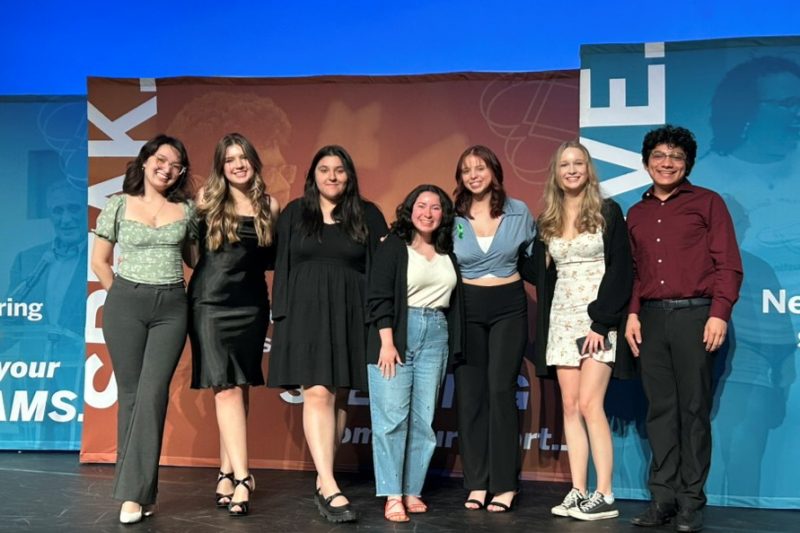Omitting ‘Rare’ When Ordering A Medium Rare Burger
By Amber Williams
Reporting Texas

Katelyn Alcott, second from left; Katie Cole, third from right; and Juan Samuel Reyes, far right; and other members of the Lang Stuttering Institute Student Leadership Organization at a celebration hosted by the Arthur M. Blank Center for Stuttering Education and Research.
As a child Juan Samuel Reyes chose to remain silent even when he had something to say.
But now Reyes is one of several students who stutter at the University of Texas at Austin learning to communicate effectively while accepting their stutter through practice, community and advocacy.
“I’m in the process of becoming more comfortable with it,” Reyes said of his stutter.
Stuttering, a speech condition affecting about 70 million people or 1% of the global population, is characterized by elongated, repeated or blocked speech linked to neurophysiological and genetic factors. Although different forms of therapy exist to address the condition, many people who stutter struggle with communication abilities, job opportunities, self-esteem and overall quality of life.
“Every single time that I would stutter, I would just get reminded, ‘Oh, I can’t talk properly,’” Reyes said of his experience growing up.
“There was always a look,” Reyes said as he described the jolted-back heads and puzzled expressions he received when stuttering in front of strangers.
These interactions reinforced Reyes’ belief something was wrong with him, which encouraged him to avoid speaking in public.
“I wouldn’t raise my hand in class whenever I knew the answer, because I knew that I was going to stutter,” Reyes said.
But recently, Reyes discovered a student organization promoting stuttering acceptance and advocacy.
The organization’s main goal is to tell students “it’s OK to stutter,” said Katie Cole, a student studying speech pathology who was president of the Lang Stuttering Institute Student Leadership Organization for the 2022-2023 academic year.
The organization is connected to the Arthur M. Blank Center for Stuttering Education and Research. The Center, located at the Moody College of Communication globally serves children, teens and adults who stutter through both virtual and in-person programming.
The Blank Center takes a novel approach to stuttering, according to Courtney Byrd, the Center’s founding and executive director. Instead of trying to reduce stuttering among participants, a goal of many conventional therapy programs, the Center encourages participants to stutter openly and realize they don’t have to change the way they speak to achieve their goals, said Byrd.
“There are people all around the world, brilliant talented people, who have achieved wonderful amazing things and stutter,” Byrd said.
President Joe Biden tweeted in 2019 about having worked to overcome his stutter throughout his life. Reyes said seeing a president with a history of stuttering inspired him.
“It just feels like I can do anything,” Reyes said.
Reyes now plans to participate in the Center’s programming in the fall.
At the Center, participants are encouraged to focus on communication effectiveness over speech fluency. Through the programming, they develop non-verbal speaking skills and educate others about their stutter to correct misconceptions about their communication abilities.
“I wouldn’t be who I am without it,” said Katelyn Alcott, a student and research assistant for the Center who first joined as a program participant at age 3. Alcott said an early exposure to the program enabled her to accept stuttering from a young age.
“The only options are either to be sad about it all the time and allow it to hold me back,” Alcott said, “or just embrace it and teach others about it.”
However, Alcott said she still struggles with stepping out of her comfort zone.
“I have extreme social anxiety, so going out of my way to talk to someone is hard,” Alcott said.
Community plays a big role for Alcott during her challenges.
“Having a support group who understands you,” Alcott said, “helps you to not feel as alone.”
While people who stutter seek to be understood, others misinterpret stuttering as arising from nervousness or dumbness, according to John Hendrickson, an author and journalist who also stutters.
After writing a story in 2019 about Biden’s lifelong stuttering journey, Hendrickson received an outpouring of letters from people who stutter around the world.
“When it’s hard to physically talk, you try not to talk,” Hendrickson said, explaining why his article resonated with so many readers. “It gave people some representation.”
Those responses motivated Hendrickson to write a memoir highlighting the Blank Center along with data, stories and his own life experiences as a person who stutters.
Reyes connected to Hendrickson’s stories on a personal level. Like Hendrickson, Reyes also once omitted the word “rare” from “medium rare” while ordering a burger to avoid stuttering over the R.
Having similar experiences can help people learn to communicate more effectively with their stutter, said Daniel Reese, the assistant director of clinical education and research at the Blank Center who helps run the programming.
As both a trained speech language pathologist and a person who stutters, Reese said he helps participants by modeling researched communication techniques in his own life.
“I was there too,” Reese said of his ability to understand the participants’ perspectives.
As students learn to coexist with their stutter, they also learn to help people who do not stutter do that too.
Reyes said non-stutterers should actively engage with people who stutter and take time to listen.
“It’s OK,” Reyes said, “to stutter.”